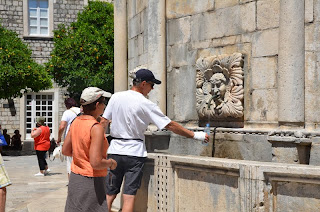View from the Placa.
This is a monument of Ivan Gundulic. You'll notice the pigeon on his head. Every day at noon a man comes to feed the pigeons. The pigeons start lining up right before noon waiting to be fed.

Typical street in Dubrovnik
These are pictures of the destruction that was done during the war. Ivana said it was very frightening and did a considerable amount of damage.
This is the Big Onofrio Fountain, from the 15th Century. The fountain has both practical and decorative function. The fountains existed only in the most distinguished places in Dubrovnik.
This church was the only church that was not destroyed in the earth quake in the 1700s.
This decorative skirt was built along the staircase to provide modesty to the women climbing the stairs. The skirt prevented people from looking up the women's dresses and kept people from seeing their legs as they raised their skirts to climb the stairs.
Stairway to the Monastery
We followed these steps up the wall of the city and found a great little cafe tucked away in the cliffs. We sat and had a drink and watched the people jump off the cliffs into the Adriatic Sea. They had the right idea. It was in the high 90s and we were really hot.
Paula, Dad, Brian and Ante took a boat out to Lopud Island. This was our view of the island from the cafe on the cliffs.
View of Dubrovnik from the boat.
Lopu is the most developed island of the Elaphite Islands. In the 16th Century the people were engaged in the shipping industry and they became quite wealthy. They built luxurious houses and by the end of the 16th Century Lopudhad 30 churches and 2 monasteries.









